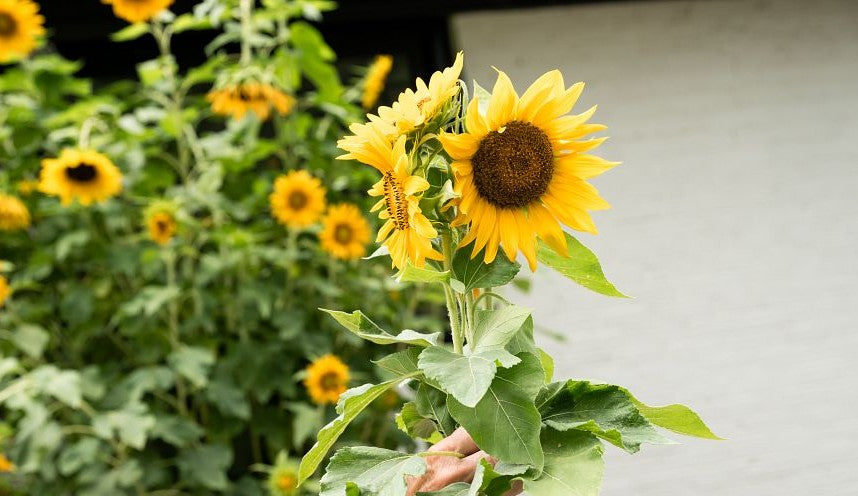A Complete Guide for GreenStalk Gardeners
Fresh-cut flowers from your own garden last longer and cost less than store-bought bouquets. A single GreenStalk Vertical Planter gives you space to grow focal flowers, fillers, and foliage for complete arrangements all season long. Shorter flower varieties work best in vertical systems since they won't become top-heavy or need staking.
This guide will introduce you to popular cut flower varieties and teach you how to transform your GreenStalk into your personal flower market.

Flower Varieties That Thrive in Your GreenStalk
The balance of cut flower gardening lies in choosing varieties that thrive in pockets while creating the layered beauty of a professional arrangement. Shorter varieties actually create fuller displays in vertical systems, as they won't be too top-heavy or require extensive staking.
Selecting your palette for a living bouquet:
Focal Flowers : Dwarf sunflowers like 'Sunspot' reach 2-3 feet and produce 6-inch blooms in 70-80 days. Zinnias grow 12-18 inches tall (depending on the variety) with 2-4 inch flowers in nearly every color, blooming continuously once they start. Tulips provide early spring color and are one of many bulbs you can experiment with in your GreenStalk.
Filler Flowers : Cosmos and marigolds are excellent choices that add volume and texture without overwhelming focal blooms. Snapdragons provide leading lines and come in countless colors.
Aromatic Foliage : Sage adds silvery-green texture, floral eucalyptus brings elegant blue-green tones, and lavender contributes both color and heavenly fragrance.
The 3 Tier GreenStalk Original Vertical Planter is a complete bouquet ecosystem — each tier contributing different elements to spark your creativity.


Keeping Your Living Bouquet in Constant Bloom
Succession planting helps to prevent the feast-or-famine cycle that leaves gardens overflowing with flowers one week, then bare the next.
Flower farmers know that succession planting provides a continuous harvest of crops all season long, as each variety of cut flowers has an optimal lifespan as production plants before they begin to tire. Prolific bloomers like zinnias and cosmos benefit from sowings spaced 3-4 weeks apart for continuous production. Start your first planting 2-3 weeks after your last frost date, then sow new seeds every 3-4 weeks through midsummer.
Here's how to maintain constant color:
Direct Sowing Strategy : Direct Sowing Strategy: Plant seeds directly in pockets every 2-3 weeks rather than transplanting, as most cut flowers prefer undisturbed roots. Sow 6 - 8 seeds per pocket and thin to the strongest 1 - 5 plants (depending on the variety) once they're 2 inches tall.
Mix Fast and Slow : Combine quick-blooming flowers like cosmos (60-70 days) with slower varieties like sunflowers (80-90 days) planted at the same time. This creates natural succession as different flowers reach peak bloom at staggered intervals.
Transplant Additions : Plant sage, floral eucalyptus, and lavender transplants early in the season — these provide consistent foliage for every bouquet while your flowering plants cycle through their successions.
Your garden becomes a living calendar of blooms, ensuring you always have the perfect combination of colors and textures for gifting fresh bouquets to loved ones or simply brightening your own home.
Professional Techniques for Maximum Yield

The difference between a sparse plant and a bushy, flower-filled beauty often comes down to one simple technique: pinching. This professional secret can double, triple, or even quadruple your stem production, making your GreenStalk a bouquet factory.
When your cut flowers reach 8-12 inches tall with several sets of true leaves, it's time to pinch. The process is surprisingly simple yet dramatically effective.
The Pinching Process :
When : Young plants between 8-12 inches tall, before they set their first buds
How : Using clean Garden Shears , cut 3-4 inches off the tender top growth just above a node or set of leaves
Why : Removing the central growing tip forces plants to develop multiple side shoots, resulting in bushier, more productive plants
Which Flowers : Calendula, celosia, and sweet peas benefit most from pinching, as do cosmos and zinnias. These "cut-and-come-again" flowers reward you with more blooms the more you harvest
Pinched plants create perfectly proportioned displays in pockets, filling out horizontally rather than growing too tall. Be sure to research the plants you’ve chosen and, if you’re the planning type, consider starting a Garden Journal to keep track of what you learn. Once you begin harvesting regularly, each cut acts as continued pinching, extending your bloom season and encouraging even more flower production.

Your sage, floral eucalyptus, and lavender also benefit from regular harvesting, which keeps them bushy and productive. Pruning them will prolong their leafy season, while allowing them to grow unmanaged will produce tall, leggy stalks with petite blossoms, depending on the plant.
Growing your own cut flowers gives you varieties you can't find at stores and arrangements that last longer than purchased bouquets. Start with these reliable varieties, then experiment with other compact flowers that catch your eye. We'd love to see your vertical cut flower garden! Share photos with us at support@greenstalkgarden.com!












